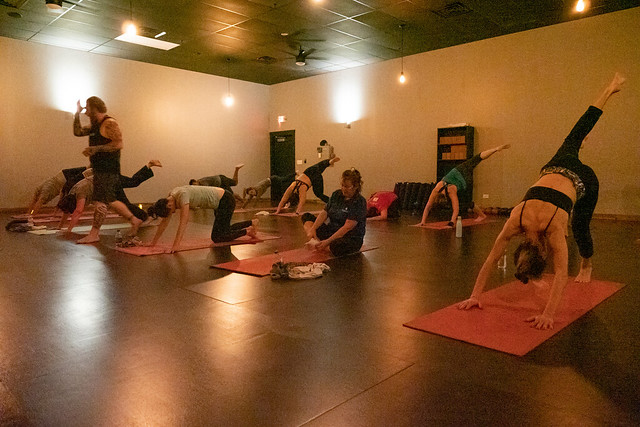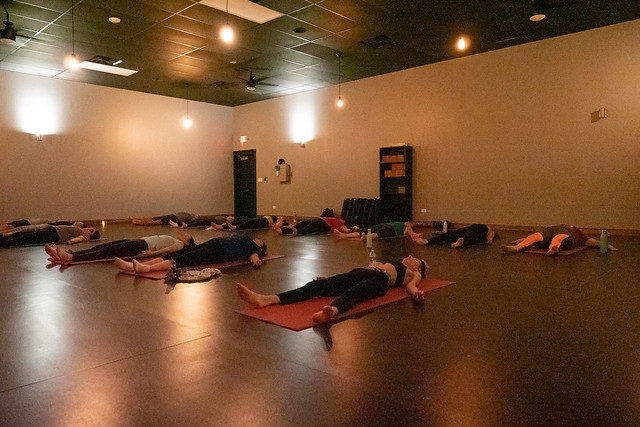Cardio is a crucial part of staying physically fit. While hopping the treadmill or hitting your local trail may seem like an easy way to burn calories and get your heart rate pumping, it’s not always an attractive choice. More and more people are opting for yoga as a form of cardio exercise, but how exactly does it compare to running?

Livestrong recently compared the two and the benefits they provide when it comes to cardio activities.
- Calories
- Weight loss comes down to burning more calories than you consume, regardless of how those calories are burned. As long as an activity keeps your body in a calorie deficit, it can aid in weight loss; in theory, this means both yoga and running can help you drop pounds. However, running burns far more calories per minute than yoga, meaning it helps you lose weight at a much faster rate. To give you a better understanding of the difference in calories burned between yoga and running, consider that a 150-lb. person burns 240 calories during an hour of regular yoga and 786 calories in an hour of running.
- Muscle Gains
- An important aspect of any exercise routine is strength training; building muscle helps you improve your strength and stamina, reduce your risk of injury and burn more calories even at rest. Both yoga and running can help you build lean muscle, but neither should replace regular strength-training sessions. Together with yoga or running, lifting weights can help you lose weight faster by increasing your calorie expenditure.
- Diet
- Whether it’s running, yoga, strength training or anything else, exercise is an important part of successful weight loss. But no matter what you choose, don’t forget about the role of a healthy diet for slimming down. Many people find that they can cut more calories through dieting than they can burn through exercise; by combining the two, you can lose weight and improve your strength without feeling hungry. Be sure your diet includes plenty of fruits and vegetables, whole grains, lean protein and low-fat dairy to provide the energy you need to power through exercise.
Runner’s World took a similar dive into the debate and asked the question, “can a yoga session replace a run?” Here is some of what they found…
There are, of course, many forms of yoga, from those that focus on breathing and feature mostly sitting postures to those that entail holding complex standing poses and moving quickly through a series of poses. A survey found that there’s equally great variety in these sessions’ intensity. Most were found to have a score of 2 to 3 on what’s known as metabolic equivalent of task (MET), a system used to compare energy expended in various activities. A MET score of 1 is considered the baseline, and corresponds to sitting or otherwise being sedentary. A MET score of 3 means an activity has roughly the same energy expenditure as walking at a leisurely pace. Activities with a MET score of 2 to 3 are considered light activity.
A key exception was surya namaskar, or sun salutation. This is a series of standing, lunging and other poses, done relatively quickly and usually repeated two to six times. Depending on how vigorously they’re done, sun salutations typically produce a MET score of 3 to 6, which is considered moderate activity. (By way of comparison, running at 9:00-per-mile pace has a MET score of 10.5, well into what’s considered vigorous activity). In one study, sun salutations were done vigorously enough to produce a MET score of 7.4, the equivalent of a walk-run combination averaging between 12:00 and 15:00 per mile.
Jogging is a form of aerobic exercise, as it increases your heart rate, pulse and breathing rate. Regular aerobic exercise increases your cardiovascular health and reduces your risk of stroke, some cancers, obesity, heart disease and high blood pressure. Jogging, like yoga, is also weight-bearing exercise, which reduces your risk of osteoporosis. Jogging is a medium to high-impact form of weight-bearing exercise, while yoga create a low impact. Although some yoga can be aerobic, it is typically significantly less aerobic than jogging. Benefits of yoga include helping you build a lean body, increasing your flexibility and relaxing your mind.
The movement in yoga is from pose to pose, rather than location to location — during a yoga session you will stay in the same room or outdoor area. Jogging can be undertaken at a variety of indoor or outdoor locations, which can boost your motivation to continue with a regular exercise regimen. You can jog in city parks, on rural dirt roads, or even in the wilderness as a trail runner. Seeing a variety of landscapes and terrains is a great motivator and combats the monotony of a regular exercise schedule.

We asked some of our professional staff members the simple question: is yoga good for cardio? Here are some of their answers!
Definitely, it teaches a person how to mange there respiration, and control cardiac function, and builds better lung capacity. This is very important while maintaining long works periods/time which burns fat more efficiently – Humberto Medina, Operations Manager
Yes, I think yoga is good for cardio because it can help get the heart rate up and get you either warmed up or cooled down after an intense workout. Yoga can be helpful to people who have weaker knees because this is a low impact workout – Priscilla Rodriguez, Yoga Instructor
Yoga is good for cardio in a sense that there’s always an opportunity to choose your level of intensity during your practice to take it to your edge while strengthening and lengthening your muscles. – Angela Salazar, Yoga Instructor
You can definitely get your heart rate up during a yoga class and yoga keeps your heart nice and healthy but I don’t look at yoga as a traditional form of cardio or any other workout for that matter. Yoga is a work in not a work out – Miwa Gardi, Founder

